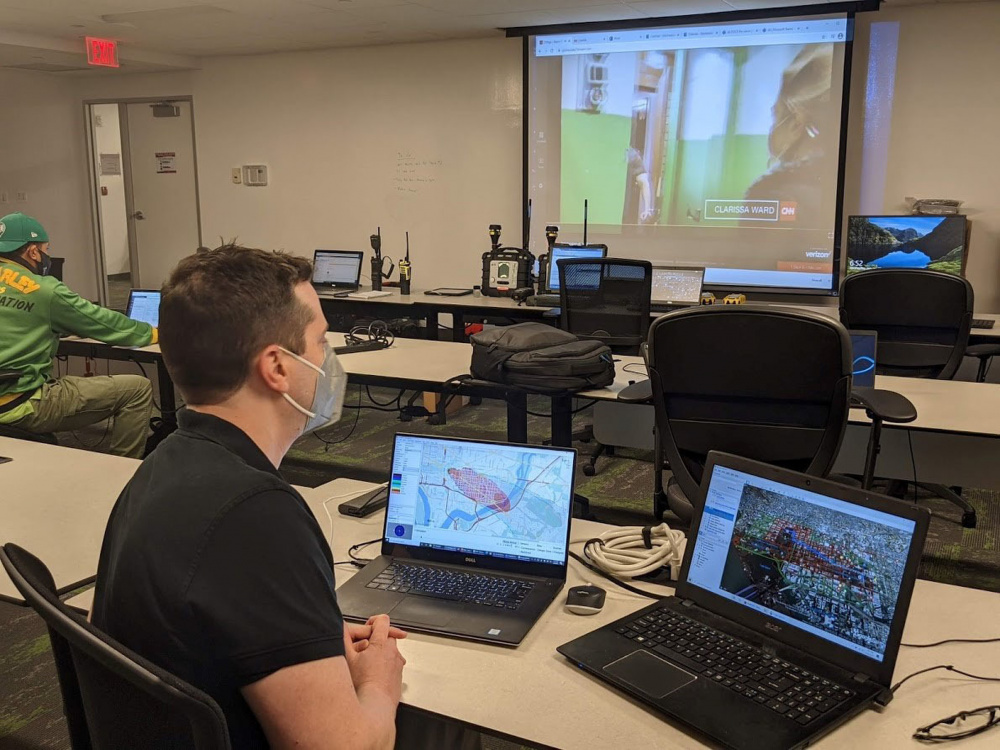When seconds matter, speed saves lives. That’s why Adam Moses, a U.S. Naval Research Laboratory (NRL) computer scientist, was part of the massive security effort behind the inauguration of President Joe Biden.
Moses deployed a 3D computer-simulated modeling program, called Contaminant Transport Analyst, or CT-Analyst, which can track the release of chemical, biological, and radioactive substances that can spread large distances in minutes.
“CT-Analyst aims to be the fastest, most-accurate hazardous airborne plume modeling tool available to both military and civilian first-responders,” Moses said. “CT-Analyst is easily learned and provides a depth of capability and reporting options that respond well to fast-changing situations.”
This was the fourth presidential inauguration the program played a role in, having previously been involved in the 2013 and 2017 inaugurations. NRL hosted the hazmat modeling reach-back center in 2009, and was deployed with the Federal Protective Service for the 2005 inauguration.
In addition, CT-Analyst has supported security for several Super Bowls, the Academy Awards, and other national special security events (NSSE).
The software was developed by researchers in NRL’s Laboratories for Computational Physics and Fluid Dynamics. Continuous improvement of this state-of-the-art modeling software makes it extremely valuable to first responders around the nation.
Moses was embedded with an emergency response team during the most recent inauguration at the D.C. Department of Energy and Environment (DOEE) in northeast D.C. He monitored reports from the DOEE team in addition to keeping an eye on social media for anything suspicious.
It was fortunately a pretty quiet day, Moses said, but there were occasions that called for specific reporting based on potential threats and CT-Analyst was able to respond quickly and effectively.
Jayne Deichmeister, chief of Emergency Response at the DOEE, said she was impressed with the capabilities of the software while on duty with Moses during the inauguration. “I appreciated it as an immediate resource,” she said. “It’s quick, and that’s really helpful.”
While she’s still learning about all of the program’s capabilities, she was able to see how it works during an exercise before the inauguration. She was the liaison between the D.C. Homeland Security and Emergency Management Agency’s operations center and the EPA during the exercise, where a number of hazardous releases were simulated. She and her team plan to learn more about the program in subsequent demonstrations with Moses.
The program performs best on urban environments at city-sized scales, making it a perfect fit for NSSE’s. The software’s highly accurate 3D models detail how plumes spread over water, in open spaces, in between tall buildings and even through trees.
Moses did a lot of legwork to improve the software prior to the inauguration. The program runs easily on a regular laptop, and does not require an internet connection to perform its basic functions. This enables it to operate in situations where stable communications may not be available.
Information was sourced from the D.C. Geographic Information System office, which has 3D representations of every building in the city, as well as the U.S. Geological Survey, which maps terrain for the entire world.

“It’s pretty impressive,” Moses said. “We can actually go into the detail of how a plume will be altered through trees.”
CT-Analyst also produces information about the effects dangerous chemicals have on people. It uses a rating system called Protective Action Criteria (PAC) values. PAC values give quick reporting on health consequences while inside a plume, from no effects whatsoever to severe incapacitation. In addition, CT-Analyst can quickly indicate the direction of a plume and expected arrival times in increasing intervals, from 5, 10, 30, minutes to an hour.
“This is important information for first responders,” Moses said. “It gives you a very quick snapshot of a given release.”
While there are other modeling programs commonly used by first-responders worldwide, the most current CT-Analyst distinguishes itself by producing results in milliseconds. Other modeling software can require minutes or hours to calculate similar information depending on the complexity of the situation.
“By pre-modeling plumes within a selected urban environment,” Moses said, “our predictions require only a table lookup as opposed to a complete recalculation. That’s important when lives can be saved with on-the-fly capability.”
In addition to lightning-fast results, CT-Analyst can export its information to a variety of other commonly used platforms like Google Earth or Microsoft PowerPoint. CT-Analyst is also user-friendly for first responders and emergency decision makers, and does not require expert knowledge of 3D modeling or hazard plume prediction mechanics.
Users can click and drag an initial plume to change when new information changes the model. First reports are often wrong, especially in chaotic situations, so the software is able to change according to new information, such as where the release occurred. In addition, the software can “backtrack,” reversing its direction so that the point of origin can be identified.
“In a real situation you may not know the what, when, where, or how a particular hazard was released.” Moses said. “A bad actor doesn’t tend to call in to tell you what has happened.”
There may only be reports of people getting sick or incapacitated.
“Most releases aren’t big, ominous, yellow clouds of gas,” he said. “In many situations these are releases that you can’t actually see or smell. You may only be able to see what your chemical sensors in the city are telling you, or possibly reports of people reacting to the hazardous toxins in the air.”
CT-Analyst software can create a plume based on a small amount of information, such as an unattended back pack or suspicious white powder.
“It doesn’t need to know much about the actual release short of where it generally came from,” Moses said. “Then you can refine the model as you get more information.”
Story adapted from Kevin McAndrews, U.S. Naval Research Laboratory



